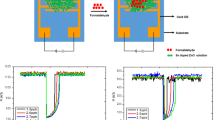Abstract
Formaldehyde (HCHO), a colorless and pungent-smelling gas, is confirmed be a huge threat to human health. The detection of formaldehyde is necessary and important. The Poly(3-hexythiophene) (P3HT)/ZnO organic-inorganic composite thin film was fabricated and used as the sensitive layer of organic thin film transistors (OTFT) by spray-deposited method to detect HCHO at room temperature. The process parameters such as P3HT/ZnO weight ratios and airbrushed masses were optimized. The results showed that P3HT/ZnO OTFT exhibited good sensing response to HCHO. Airbrushed mass of 1ml was the optimal mass, and the 1:1 and 1:5 weight ratios of P3HT/ZnO exhibited better sensing properties compared with others. OTFT gas sensors based on P3HT/ZnO composite film provides a novel promising approach to the detection of HCHO.
Similar content being viewed by others
References
Ryan M A, Zhou H, Buehler M G, et al. Monitoring space shuttle air quality using the Jet Propulsion labotatory electronic nose. IEEE Sensor J, 2004, 4: 337–347
Hu W L, Chen S Y, Liu L T, et al. Formaldehyde sensors based in nanofibrous polyethyleneimine/bacterial cellulose membranes coated quartz crystal microbalance. Sens Actuators B, 2011, 157: 554–559
Filho O F, Suleiman A A, Guilbault G G. Piezoelectric crystal sensor for the determination of formaldehyde in air. Talanta, 1991, 38: 541–545
Zhou K W, Ji X L, Zhang N, et al. On-line monitoring of formaldehyde in air by cataluminescence-based gas sensor. Sens Actuators B, 2006, 119: 392–397
Horstjann M, Bakhirkin Y A, Kosterev A A, et al. Formaldehyde sensor using interband cascade laser based quartz-enhanced photoacoustic spectroscopy. Appl Phys B, 2004, 79: 799–803
Peng L, Zhao Q D, Wang D J, et al. Ultraviolet-assisted gas sensing: A potential formaldehyde detection approach at room temperature based on zinc oxide nanorods. Sens Actuators B, 2009, 136: 80–85
Han N, Tian Y J, Wu X F, et al. Improving humidity selsectivity in formaldehyde gas sensing by a two-sensor array made of Ga-doped ZnO. Sens Actuators B, 2009, 138: 228–235
Wang R X, Zhang D J, Zhang Y M, et al. Boron-doped carbon nanotubes serving as a novel chemical sensor for formaldehyde. J Phys Chen B, 2006, 110: 18267–18271
Lu Y J, Meyyappan M, Li J. A carbon-nanotube-based sensor array for formaldehyde detection. Nanotechnol, 2011, 11: 055502
Wang L, Fine D, Sharma D, et al. Nanoscale organic and polymeric field-effect transistors as chemical sensors. Anal Bioanal Chem, 2005, 384: 310–321
Street R A, Thin-film transistors. Adv Mater, 2009, 21: 2007–2022
Torsi L, Dodabalapur A, Sabbatini L, et al. Multi-parameter gas sensors based on organic thin-film-transistors. Sens Actuators B, 2007, 67: 312–316
Yan J F, Wu Z M, Tai H L, et al. The investigation of the formaldehyde gas sensor based on organic thin-film transistors. In: The IEEE International Conference on Apperceiving Computing and Intelligence Analysis. Chengdu: IEEE, 2010. 213–216
Liu B, Xie G Z, Du X S, et al. Poly (3-hexylthiophene) based organic field-effect transistor as NO2 gas sensor. Proc SPIE, 2009, 7508: 750813-1
Fukuda H, Yamagishi Y, Ise M, et al. Gas sensing of properties of Poly-3-hexylthiophene thin film transistors. Sens Actuators B, 2005, 108: 414–417
Jeong J W, Lee Y D, Kim Y M, et al. The response characteristics of a gas sensor based on Poly-3-hexylthiophene thin-film transistors. Sens Actuators B, 2010, 146: 40–45
Navan R R, Panigraphy B, Baghini M S, et al. Mobility enhancement of solution-processed Poly (3-hexylthiophene) based organic transistor using zinc oxide nanosturctures. Compos Part B-Eng, 2012, 43: 1645–1648
Li X, Jiang Y D, Xie G Z, et al. Copper phthalocyanine thin film transistors for hydrogen sulfide detection. Sens Actuators B, 2013, 176: 1191–1196
Green R, Morfa A, Ferhuson A J, et al. Performance of bulk heterojunction photovoltaic devices prepared by airbrush spray deposition. Appl Phys Lett, 2008, 92: 033301
Chan C K, Richter L J, Dinardo B, et al. High performance airbrushed organic thin film transistors. Appl Phys Lett, 2010, 96: 133304
Azarova N A, Owen J W, Mclellan C A, et al. Fabrication of organic thin-film transistors by spray-deposition for low-coat, large-area electronics. Org Electron, 2010, 11: 1960–1965
Someya T, Dodabalapur A, Huang J, et al. Chemical and physical sensing by organic field — effect transistors and related devices. Adv Mater, 2010, 22: 3799
Guillaud G, Simon J, Germain J P. Metallophthalocyanines Gas sensors, resistors and field effect transistors. Chem Soc Rev, 1998, 178–180: 1433–1484
Bohrer F I, Sharoni A. Gas sensing mechanism in chemiresistive cobalt and metal-free phthalocyanine thin films. J Am Chem Soc, 2007, 129: 5640–5646
Saxena V, Aswal K D, Kaur M, et al. Enhanced NO2 selectivity of hybrid poly(3-hexylthiophene): ZnO-nanowire thin films. Appl Phys Lett, 2007, 90: 043516
Hsieh G W, Li F M, Beecher P, et al. High performance nanocomposite thin film transistors with bilayer carbon nanotube-polythiphene active channel by ink-jet printing. J Appl Phys, 2009, 106: 123706
Park Y D, Lim J A, Jiang Y, et al. Enhancement of the field-effect mobility of poly(3-hexylthiophene)/functionalized carbon nanotube hybrid transistors. Org Elec, 2008, 9: 317–322
Trogler W C. Chemical sensing with semiconducting metal phthalocyanines. Struct Bond, 2012, 142: 91–118
Author information
Authors and Affiliations
Corresponding author
Rights and permissions
About this article
Cite this article
Li, X., Jiang, Y., Tai, H. et al. The fabrication and optimization of OTFT formaldehyde sensors based on Poly(3-hexythiophene)/ZnO composite films. Sci. China Technol. Sci. 56, 1877–1882 (2013). https://doi.org/10.1007/s11431-013-5268-4
Received:
Accepted:
Published:
Issue Date:
DOI: https://doi.org/10.1007/s11431-013-5268-4




